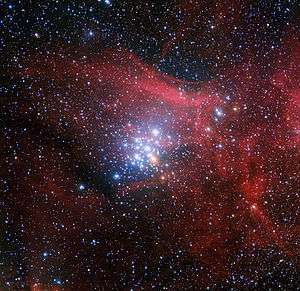NGC 3293
| NGC 3293 | |
|---|---|
|
NGC 3293 taken by the Wide Field Imager on the MPG/ESO 2.2-meter telescope | |
| Observation data | |
| Constellation | Carina |
| Right ascension | 10h 35m 24s[1] |
| Declination | −58° 14′[1] |
| Distance | 9,000 ly (2,750 pc[2]) |
| Apparent magnitude (V) | 4.7 |
| Apparent dimensions (V) | 8.2′[2] |
| Physical characteristics | |
| Radius | 13.2 ly[2] |
| Estimated age | 8 Myr[2] |
NGC 3293 is an open cluster in the Carina constellation. It was discovered by Abbe Lacaille in 1751-52. It consists of more than 100 stars brighter than 14th magnitude in a 10 arc minute field, the brightest of which are blue supergiants of apparent magnitude 6.5 and 6.7. There is also a 7th magnitude pulsating red supergiant, V361 Carinae.[3]
External links
- NGC 3293 @ SEDS NGC objects pages
- NASA Astronomy Picture of the Day: NGC 3293: A Bright Young Star Cluster (6 April 2015)
References
- 1 2 Kharchenko, N. V.; Piskunov, A. E.; Schilbach, E.; Röser, S.; Scholz, R.-D. (2013). "Global survey of star clusters in the Milky Way. II. The catalogue of basic parameters". Astronomy & Astrophysics. 558: A53. arXiv:1308.5822
 . Bibcode:2013A&A...558A..53K. doi:10.1051/0004-6361/201322302.
. Bibcode:2013A&A...558A..53K. doi:10.1051/0004-6361/201322302. - 1 2 3 4 Baume, G.; Vázquez, R. A.; Carraro, G.; Feinstein, A. (2003). "Photometric study of the young open cluster NGC 3293". Astronomy and Astrophysics. 402 (2): 549. arXiv:astro-ph/0301529
 . Bibcode:2003A&A...402..549B. doi:10.1051/0004-6361:20030223.
. Bibcode:2003A&A...402..549B. doi:10.1051/0004-6361:20030223. - ↑ Dufton, P. L.; Smartt, S. J.; Lee, J. K.; Ryans, R. S. I.; Hunter, I.; Evans, C. J.; Herrero, A.; Trundle, C.; Lennon, D. J.; Irwin, M. J.; Kaufer, A. (2006). "The VLT-FLAMES survey of massive stars: Stellar parameters and rotational velocities in NGC 3293, NGC 4755 and NGC 6611". Astronomy and Astrophysics. 457: 265. arXiv:astro-ph/0606409
 . Bibcode:2006A&A...457..265D. doi:10.1051/0004-6361:20065392.
. Bibcode:2006A&A...457..265D. doi:10.1051/0004-6361:20065392.
This article is issued from Wikipedia - version of the 9/27/2016. The text is available under the Creative Commons Attribution/Share Alike but additional terms may apply for the media files.
